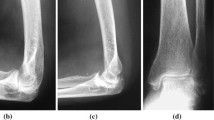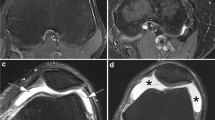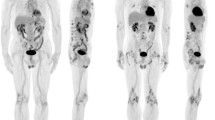Abstract
Purpose
The aim of this study was to assess rheumatoid arthritis (RA) synovitis with positron emission tomography (PET) and 18F-fluorodeoxyglucose (18F-FDG) in comparison with dynamic magnetic resonance imaging (MRI) and ultrasonography (US).
Methods
Sixteen knees in 16 patients with active RA were assessed with PET, MRI and US at baseline and 4 weeks after initiation of anti-TNF-α treatment. All studies were performed within 4 days. Visual and semi-quantitative (standardised uptake value, SUV) analyses of the synovial uptake of FDG were performed. The dynamic enhancement rate and the static enhancement were measured after i.v. gadolinium injection and the synovial thickness was measured in the medial, lateral patellar and suprapatellar recesses by US. Serum levels of C-reactive protein (CRP) and metalloproteinase-3 (MMP-3) were also measured.
Results
PET was positive in 69% of knees while MRI and US were positive in 69% and 75%. Positivity on one imaging technique was strongly associated with positivity on the other two. PET-positive knees exhibited significantly higher SUVs, higher MRI parameters and greater synovial thickness compared with PET-negative knees, whereas serum CRP and MMP-3 levels were not significantly different. SUVs were significantly correlated with all MRI parameters, with synovial thickness and with serum CRP and MMP-3 levels at baseline. Changes in SUVs after 4 weeks were also correlated with changes in MRI parameters and in serum CRP and MMP-3 levels, but not with changes in synovial thickness.
Conclusion
18F-FDG PET is a unique imaging technique for assessing the metabolic activity of synovitis. The PET findings are correlated with MRI and US assessments of the pannus in RA, as well as with the classical serum parameter of inflammation, CRP, and the synovium-derived parameter, serum MMP-3. Further studies are warranted to establish the place of metabolic imaging of synovitis in RA.
Similar content being viewed by others
References
Beckers C, Ribbens C, André A, Marcellis S, Kaye O, Mathy L, et al. Assessment of disease activity in rheumatoid arthritis with 18F-FDG PET. J Nucl Med 2004;45:956–64
Østergaard M, Lorenzen I, Henriksen O. Dynamic gadolinium-enhanced; MR imaging in active and inactive immunoinflammatory gonarthritis. Acta Radiol 1994;35:275–81
Østergaard M, Szkudlarek M. Imaging in rheumatoid arthritis−why MRI and ultrasonography can no longer be ignored. Scand J Rheumatol 2003;32:63–73
Østergaard M, Stoltenberg M, Løvgreen-Nielsen P, Volck B, Sonne-Holm S, Lorenzen I. Quantification of synovitis by MRI: correlation between dynamic and static gadolinium-enhanced magnetic resonance imaging and microscopic and macroscopic signs of synovial inflammation. Magn Reson Imaging 1998;16:753–8
Gaffney K, Cookson J, Blades S, Coumbe A, Blake D. Quantitative assessment of the rheumatoid synovial microvascular bed by gadolinium-DTPA enhanced magnetic resonance imaging. Ann Rheum Dis 1998;57:152–7
Østergaard M, Court-Payen M, Gideon P, Wieslander S, Cortsen M, Lorenzen I, et al. Ultrasonography in arthritis of the knee. A comparison with MR imaging. Acta Radiol 1995;36(1):19–26
Rubaltelli L, Fiocco U, Cozzi L, Baldovin M, Rigon C, Bordoletto P, et al. Prospective sonographic and arthroscopic evaluation of proliferative knee joint synovitis. J Ultrasound Med 1994;13:855–62
Walther M, Harms H, Krenn V, Radke S, Faehndrich TP, Gohlke F. Correlation of power Doppler sonography with vascularity of the synovial tissue of the knee joint in patients with osteoarthritis and rheumatoid arthritis. Arthritis Rheum 2001;44:331–8
Palmer WE, Rosenthal DI, Schoenberg OI, Fischman AJ, Simon LS, Rubin RH, et al. Quantification of inflammation in the wrist with gadolinium-enhanced MR imaging and PET with 2-[F-18]-fluoro-2-deoxy-d-glucose. Radiology 1995;196:647–55
Roivainen A, Parkkola R, Yli-Kerttula T, Lehikoinen P, Viljanen T, Mottonen T, et al. Use of positron emission tomography with methyl-11C-choline and 2-18F-fluoro-2-deoxy-d-glucose in comparison with magnetic resonance imaging for the assessment of inflammatory proliferation of synovium. Arthritis Rheum 2003;48:3077–84
Ribbens C, André B, Marcelis S, Kaye O, Mathy L, Bonnet V, et al. Rheumatoid hand joint synovitis: gray scale and power Doppler US quantifications following anti-tumor necrosis factor-alpha treatment: pilot study. Radiology 2003;229:562–9
Ribbens C, Martin y Porras M, Franchimont N, Kaiser MJ, Jaspar JM, Damas P, et al. Increased matrix metalloproteinase-3 serum levels in rheumatic diseases: relationship with synovitis and steroid treatment. Ann Rheum Dis 2002;61:161–6
Arnett FC, Edworthy SM, Bloch DA, McShane DJ, Fries JF, Cooper NS, et al. The American Rheumatism Association 1987 revised criteria for the classification of rheumatoid arthritis. Arthritis Rheum 1988;31:315–24
Conaghan P, Lassere M, Ostergaard M, Peterfy C, McQueen F, O’Connor P, et al. OMERACT rheumatoid arthritis magnetic resonance imaging studies. Exercise 4: an international multicenter longitudinal study using the RA-MRI score. J Rheumatol 2003;30:1376–9
Cimmino MA, Innocenti S, Livrone F, Magnaguagno F, Silvestri E, Garlaschi G. Dynamic gadolinium-enhanced magnetic resonance imaging of the wrist in patients with rheumatoid arthritis can discriminate active from inactive disease. Arthritis Rheum 2003;48:1207–13
Smeets TJM, Kraan MC, van Loon ME, Tak PP. Tumor necrosis factor alpha blockade reduces the synovial cell infiltrate early after initiation of treatment, but apparently not by induction of apoptosis in synovial tissue. Arthritis Rheum 2003;48:2155–62
Acknowledgements
We would like to thank E. Mailleux for her expertise in joint assessment and E. Deflandre, C. Lust, C. Hauwaert, M. Hirsh and A.M. Jeugmans for their clinical collaboration.
This work was supported by a grant from the F.I.R.S. (CHU Liège)
Author information
Authors and Affiliations
Corresponding author
Rights and permissions
About this article
Cite this article
Beckers, C., Jeukens, X., Ribbens, C. et al. 18F-FDG PET imaging of rheumatoid knee synovitis correlates with dynamic magnetic resonance and sonographic assessments as well as with the serum level of metalloproteinase-3. Eur J Nucl Med Mol Imaging 33, 275–280 (2006). https://doi.org/10.1007/s00259-005-1952-3
Received:
Accepted:
Published:
Issue Date:
DOI: https://doi.org/10.1007/s00259-005-1952-3




